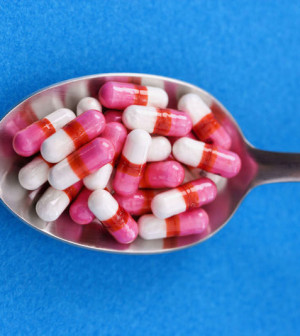- Navigating Your Midlife Crisis: Embracing New Possibilities
- City Raccoons Showing Signs of Domestication
- Mapping the Exposome: Science Broadens Focus to Environmental Disease Triggers
- One Week Less on Social Media Linked to Better Mental Health
- Your Brain Changes in Stages as You Age, Study Finds
- Some Suicide Victims Show No Typical Warning Signs, Study Finds
- ByHeart Formula Faces Lawsuits After Babies Sickened With Botulism
- Switch to Vegan Diet Could Cut Your Greenhouse Gas Emissions in Half
- Regular Bedtime Does Wonders for Blood Pressure
- Dining Alone Could Mean Worse Nutrition for Seniors
U.S. Prices Soaring for Some Generic Drugs, Experts Say


Market forces are dramatically driving up the cost of some generic drugs, prompting U.S. investigations into the pricing of what should be cheap alternatives to brand-name medications.
Generics that should cost pennies per dose have undergone radical increases in price in recent years, said Dr. Aaron Kesselheim, author of a new commentary in the New England Journal of Medicine, and director of the Program on Regulation, Therapeutics and Law at Brigham and Women’s Hospital in Boston.
For example, the widely used broad-spectrum antibiotic doxycycline has increased from 6.3 cents to $3.36 per pill. And the long-established antidepressant drug clomipramine has increased from 22 cents to $8.32 per pill, Kesselheim noted in his commentary.
Supply chain and manufacturing problems have caused some of these price hikes, he said. But Kesselheim believes that other increases have resulted from too few companies making the generic versions of these drugs.
“We take for granted that generic drugs are low-cost, but they’re only low-cost because there’s competition. When that competition goes away, the prices rise,” said Kesselheim. “Because we leave this up to the free market, this is a risk we take on.”
In response to these increases, both the U.S. Senate and the U.S. Department of Justice have undertaken investigations into generic drug pricing.
Federal prosecutors have issued subpoenas to two generic drug makers, seeking information about possible collusion between competitors, according to a published report. At the same time, the Senate Subcommittee on Primary Health and Aging has sent letters to executives of 14 pharmaceutical companies asking for answers, and on Nov. 20 will hold a hearing into the matter.
“We’ve got to get to the bottom of these enormous price increases,” subcommittee chairman Sen. Bernie Sanders, I-Vt., said in a press release announcing the hearing. “Generic drugs were meant to help make medications affordable for the millions of Americans who rely on prescriptions to manage their health needs, and now some of them are becoming unaffordable.”
Generic drugs usually are inexpensive because a number of different companies are cranking out equivalent versions of brand-name medications for which the patent has expired, Kesselheim said.
A representative of the generics industry said makers are already key players in cutting medical bills for consumers.
Generic drugs are a “critical part of system-wide efforts to hold down health care costs,” said Ralph Neas, president and CEO of the Generic Pharmaceutical Association, a trade group.
Neas noted that the world’s leading health care analytics firm, IMS Institute for Healthcare Informatics, found that generics saved $209 billion in 2012, $239 billion in 2013 and almost $1.5 trillion over the recent decade. That data was compiled by the IMS Institute on behalf of the Generic Pharmaceutical Association, according to an association news release.
However, prices have spiked for some generic drugs because some manufacturers have either merged or stopped producing those medications, creating a near or actual monopoly, Kesselheim contends.
This was the case with digoxin, an oral medication used to treat atrial fibrillation and heart failure, he noted in his editorial.
The number of generic digoxin manufacturers fell from eight to three between 2002 and 2013, after safety-related drug recalls and inspections by the Food and Drug Administration, Kesselheim wrote. As a result, the drug’s price increased 637 percent, according to the editorial.
In its most recent hike, digoxin went from 11 cents to $1.10 per pill between Oct. 2012 and June 2014, Sanders noted in his press release.
Other generic drugs have increased in price due to short supplies of the raw materials needed to produce them, or other disruptions in the manufacturing pipeline, Kesselheim said.
For example, doxycycline jumped in price due to a shortage of raw materials that reduced manufacturing capacity, he said.
When these market disruptions happen, it can be difficult for generic drug manufacturers to adjust, according to a statement from the Generic Pharmaceutical Association.
“Unlike many other types of products, generic drug manufacturers cannot simply ramp up production immediately,” the trade association statement said. The companies must meet a number of regulatory, clinical and legal requirements, on top of resolving any problems with the manufacturing process.
Ronna Hauser, vice president of pharmacy affairs for the National Community Pharmacists Association, said it’s difficult to attribute the increases in prices for some generics to any single factor.
“The reasons behind the increasing costs are varied,” she said. “It’s hard to put your finger on any particular reason.”
That’s why the upcoming Senate hearings are important, Hauser said.
“We’re trying to get some open and transparent dialogue so we can get to some of the core reasons why this is occurring,” she said. “I don’t think there’s been any clear response from drug manufacturers. They may say multiple things are leading to these price increases.”
Both Hauser and Kesselheim said these price spikes likely will only happen to specific generic medications, and that generic drugs as a whole should remain less expensive than their brand-name alternatives.
In his article, Kesselheim noted that the federal response to these increases in generic prices has been limited so far. For example, the Federal Trade Commission will not intervene unless it has evidence of anticompetitive actions that cause a sustained price increase.
But Kesselheim believes that there is an opportunity for action by the FDA.
“It can alert the public and physicians and other companies to the fact this is going on, and it can accelerate approvals of competing products that may otherwise be in the back of their drug development queue,” he said.
More information
For more information on generic drugs, visit the U.S. Food and Drug Administration.
Source: HealthDay
Copyright © 2025 HealthDay. All rights reserved.










